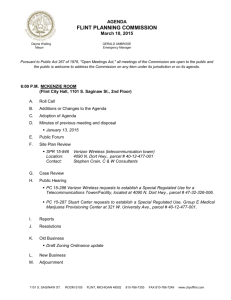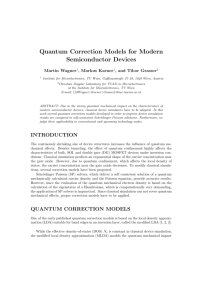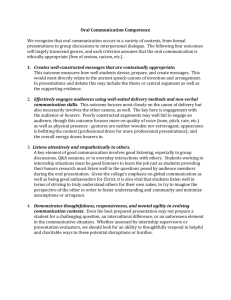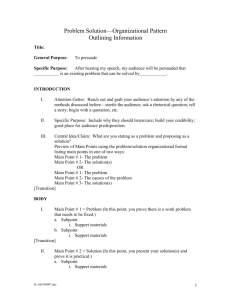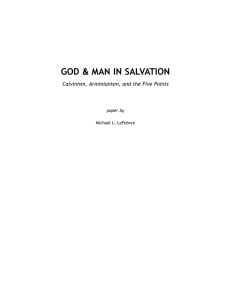A More Detailed Analysis of the Five Points of Calvinism By Steve W
advertisement
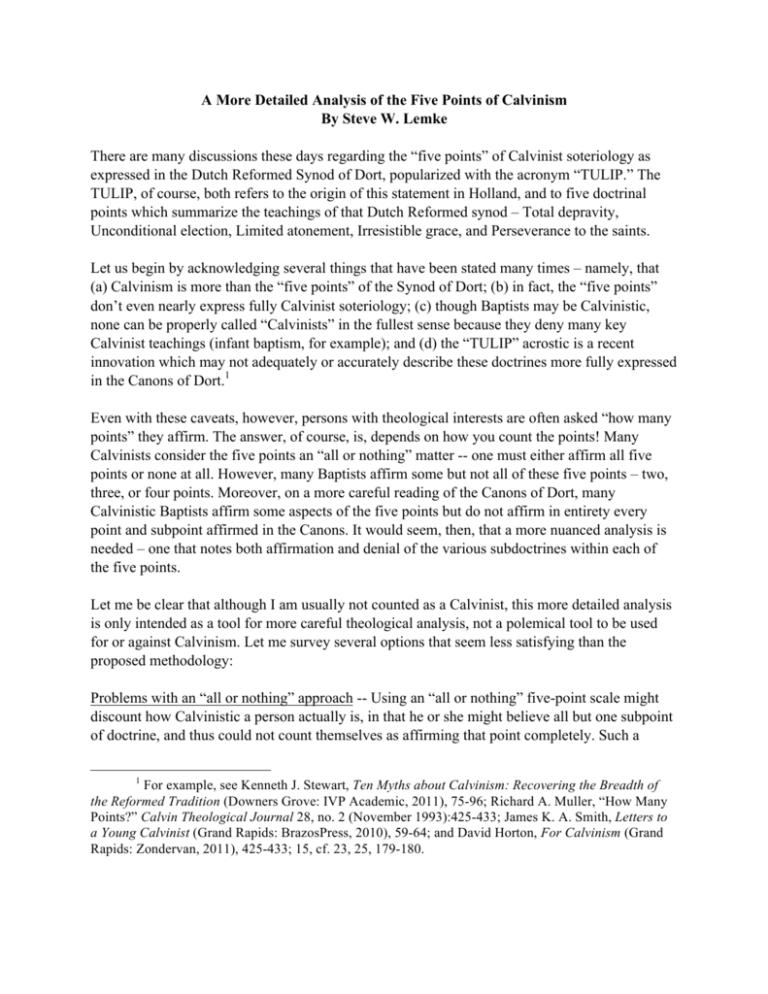
A More Detailed Analysis of the Five Points of Calvinism By Steve W. Lemke There are many discussions these days regarding the “five points” of Calvinist soteriology as expressed in the Dutch Reformed Synod of Dort, popularized with the acronym “TULIP.” The TULIP, of course, both refers to the origin of this statement in Holland, and to five doctrinal points which summarize the teachings of that Dutch Reformed synod – Total depravity, Unconditional election, Limited atonement, Irresistible grace, and Perseverance to the saints. Let us begin by acknowledging several things that have been stated many times – namely, that (a) Calvinism is more than the “five points” of the Synod of Dort; (b) in fact, the “five points” don’t even nearly express fully Calvinist soteriology; (c) though Baptists may be Calvinistic, none can be properly called “Calvinists” in the fullest sense because they deny many key Calvinist teachings (infant baptism, for example); and (d) the “TULIP” acrostic is a recent innovation which may not adequately or accurately describe these doctrines more fully expressed in the Canons of Dort.1 Even with these caveats, however, persons with theological interests are often asked “how many points” they affirm. The answer, of course, is, depends on how you count the points! Many Calvinists consider the five points an “all or nothing” matter -- one must either affirm all five points or none at all. However, many Baptists affirm some but not all of these five points – two, three, or four points. Moreover, on a more careful reading of the Canons of Dort, many Calvinistic Baptists affirm some aspects of the five points but do not affirm in entirety every point and subpoint affirmed in the Canons. It would seem, then, that a more nuanced analysis is needed – one that notes both affirmation and denial of the various subdoctrines within each of the five points. Let me be clear that although I am usually not counted as a Calvinist, this more detailed analysis is only intended as a tool for more careful theological analysis, not a polemical tool to be used for or against Calvinism. Let me survey several options that seem less satisfying than the proposed methodology: Problems with an “all or nothing” approach -- Using an “all or nothing” five-point scale might discount how Calvinistic a person actually is, in that he or she might believe all but one subpoint of doctrine, and thus could not count themselves as affirming that point completely. Such a 1 For example, see Kenneth J. Stewart, Ten Myths about Calvinism: Recovering the Breadth of the Reformed Tradition (Downers Grove: IVP Academic, 2011), 75-96; Richard A. Muller, “How Many Points?” Calvin Theological Journal 28, no. 2 (November 1993):425-433; James K. A. Smith, Letters to a Young Calvinist (Grand Rapids: BrazosPress, 2010), 59-64; and David Horton, For Calvinism (Grand Rapids: Zondervan, 2011), 425-433; 15, cf. 23, 25, 179-180. system puts Calvinism at a disadvantage by “undercounting” the points. Or, some may say they affirm the doctrinal point as a whole, even though (knowingly or unknowingly) they do not really affirm all the specific subpoints of that doctrinal point. This approach “overcounts” the number of points affirmed. Neither of these ways provides a very accurate account of how the person or confession measures up to the standards of Dort. Problems with an overly detailed approach -- On the other hand, if a much more detailed methodology were employed than the one being proposed – which assigns a numerical value to every subpoint in the affirmations and denials of the Canons of Dort – not only would it be somewhat cumbersome, but also would underreport how Calvinistic a person or doctrinal confession would actually be. In particular, most persons or confessions simply do not address all of the subpoints in the Canons, and thus could not be counted as fully Calvinistic as the Canons. The absence of such an affirmation might not mean that the person or confession actually denied the subpoints in the Canons, but the topic was simply not addressed. This would be an argument from silence. Again, that approach would underreport how Calvinistic the person or confession actually are. The balanced approach – Therefore, it appears that a modestly detailed account would avoid both of these methodological extremes, and facilitate a more accurate depiction of how “Calvinistic” (i.e., aligned with the Canons of Dort) a person or confession actually is. This, then, is the more refined methodology being proposed: each main “head of doctrine” of the Synod of Dort is broken into four component parts affirmed in that confession. The specific subpoint within the affirmations or denials of the Synod of Dort will be noted for each of these subdoctrines.2 The “head” of doctrine will be denoted with the first number (the 3rd and 4th heads of doctrine are denoted 3/4 because they are so joined somewhat in the Canons). The second number denoted is the subpoint of doctrine. Hence, “Dort, 1.2” refers to head of doctrine 1, subpoint 2. When “error” is denoted, it refers to the errors in doctrine denied in the Canons. Again, the first number denotes the head of doctrine, and the second number is the subpoint in the denial of errors section. In evaluating a doctrinal confession or statement, one-fourth of a point will be given for affirming each of these subpoints. Although this approach is somewhat artificial, this methodology will hopefully produce a more accurate assessment of specifically how near a theologian or confession measures up to the actual standards of the Synod of Dort. Hopefully, it will be a tool to help clarify theological positions more accurately, not a wedge used to divide people with theological polemics. Total Depravity consists of at least four key subdoctrines: 2 The Canons of Dort (sometimes spelled Dordt or Dordrecht) may be found in many places online (for example, see http://www.creeds.net/reformed/dordt/) as well as in many books. In this study, the references to the Canons of Dort are first to the “main points” or “heads” of doctrine, followed by the specific article under that main point (i.e., “Dort 2:4” indicates heading 2, article 4). • Universal depravity – All morally accountable persons are sinners. (Dort, 3/4.1). • Radical depravity -- The morality of even the most righteous person is as filthy rags in the sight of God; no one except Jesus even approaches righteousness (Dort, 3/4.1). • Original sin as inherited guilt – Sin and guilt are inherited from Adam, so that all humans (including infants) are born sinners by virtue of being human (Dort, 3/4.2, error 2.5, error 3/4.1). • Total inability – Persons are spiritually dead and thus incapable of seeking or responding to God. We can thus do nothing to respond to God apart from His irresistible grace (Dort, 3/4.3). Unconditional Election in a more attenuated version of Unconditional Election from the Synod of Dort would include at least these four elements: • All persons deserve condemnation – None of us is deserving of salvation. We need mercy, not justice. The marvel is that God has chosen to save anyone (Dort, 1.1, 1.5, 1.15). • Monergism, i.e., God alone initiated and accomplished salvation without human cooperation. Election is God’s sovereign choice, not based or conditioned on foreseen faith or any other human response God initiated salvation – God had a plan of salvation before we were born. Election and predestination are Biblical concepts which should not be dismissed or ignored (Dort, 1.7, 1.8). God’s election is not based or conditioned on foreseen faith or any other human response, but is simply based on His own unstated reasons (Dort, 1.6, 1.7, 1.9, 1.10). • Double predestination as God’s sovereign choice –God alone decides who goes to heaven (the elect) and hell (the reprobate), either directly (supralapsarianism) or indirectly (infralapsarianism). God made this decision before the foundation of the world, and is thus not conditioned by any human response or choice (Dort, 1.8-11, 1.14-16, 1.18). • Covenental salvation – Infants of believers who die are saved through God’s covenant with their parents (Dort, 1.17). Limited Atonement may be understood to have at least four constituent parts – • God’s “special love” for the elect – God loves the elect in a special way that He does not love other persons (D 2.8, 2.9, 2 error 6). God’s “secret” or “hidden” will is thus different than His “revealed” will, in which He affirms love for all persons (Dort, 1:7, 1:10, 1:12, 1:14, 1:18, error 1:8). • Extent/sufficiency of the atonement – The atonement is sufficient for anyone, but efficient or effective only for the elect (Dort, 2.2, 2.3). Although both high Calvinists and most other evangelical Christians agree on this point, they agree for different reasons. For strong Calvinists, it is true because Christ actually died only for the elect. The atonement is sufficient only for the elect, but none others. For more modest Calvinists, it is true because Christ’s atonement is sufficient for everyone in the world, but sinners can appropriate it only if they come to Him through faith. • Intent of the Atonement – The atonement was intended only for a “definite” and “particular” number of people, i.e., the elect (Dort, 2.8, 2.9, error 2.1). • The “Promiscuous”/“Well-Meant Offer” of the Gospel – Since we don’t know who the elect are, we should preach to all people (Dort, 2:5). This is a distinguishing mark that differentiates mainstream Calvinists from hyper-Calvinists, who worry that witnessing or preaching to the non-elect may give them the mistaken impression that they could be saved. Irresistible Grace may be understood in four constituent parts of the doctrine as expressed in the Canons of Dort: • Total inability -- Persons are spiritually dead and thus incapable of seeking or responding to God (Dort, 3/4.3). • Compatibilist Volition, not Libertarian Freedom – We do what we want or desire, thus we sin voluntarily, but we have no choice. Our wills are bound, not free (Dort, 2.3 error, 2.6 error, 3/4.10, 3/4.14, 3/4.3 error, 3/4.9 error). • Regeneration precedes conversion and justification by faith –Because of our total inability, God must regenerate persons first so that we can believe (Dort, 3/4.12, 3/4.13, 3/4.16, 3/4 .17). • Irresistible/enabling/”serious” grace -- God must provide a “serious” grace to the elect to enable them to believe, a grace that others do not receive. We have no real choice but to be changed by God (Dort, 3/4.7, 3/4.8, 3/4.10, 3/4.11, 3/4.13). Perseverance of the Saints was defined in the Canons of Dort as including at least the following four constituent parts: • God provides the assurance of election – Our salvation is assured not on our own good works, but on God’s gracious election. Salvation as monergism is not dependent on human response or participation (Dort, 5.3, 5.8, error 5.2). • True believers will persevere – True believers will be preserved by God unto salvation (Dort, 5.3, 5.6, 5.8, 5.9, 5.10). • Believers will falter due to sin, but not fall out of salvation – The elect will continue to struggle at times with sin, and in some cases fall into serious sin and pay the consequences for those sins. But they will never lose their salvation; God will pull them back through His grace (Dort, 5.1, 5.2, 5.3, 5.4). • This assurance of salvation should inspire godliness, not presumption -- True believers will respond with gratitude for God’s perseverance and live godly lives, rather than ungodly lives of sinful presumption. (Dort, 5.12, 5.13). Applying this method may lead us to discover that many Baptists are closer in doctrine than they imagined, because rather than completely affirming or denying each of the five points, we may discover that, for example, many believers may affirm .50 or .75 on one or more of the points – thus affirming some parts but not denying the entire doctrine under consideration. May this method be used to help us clarify our positions and hopefully lead us together rather than drive us apart!

